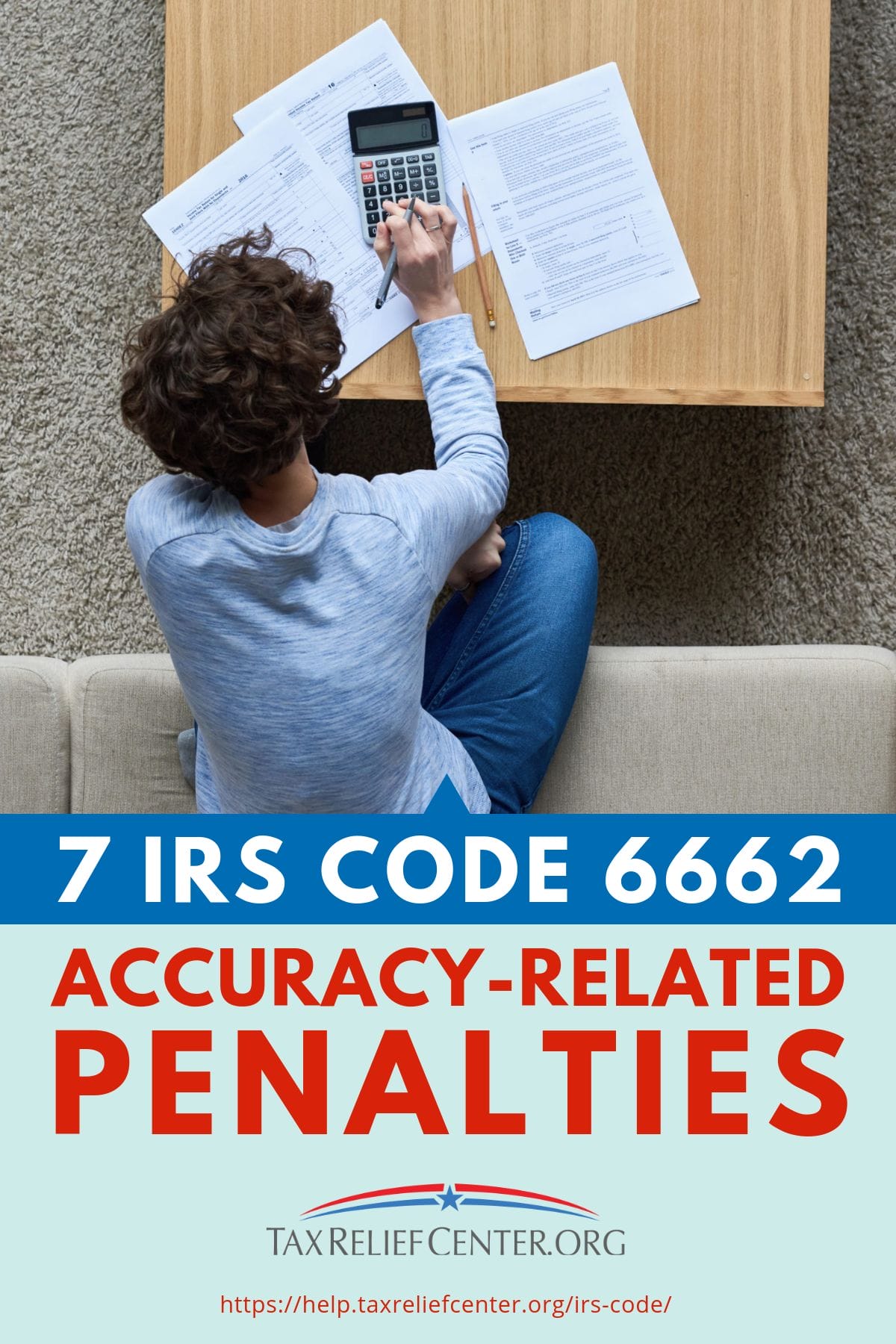Anybody can make mistakes, especially with something as complex as taxes, but the IRS code still levies penalties on inaccurate tax returns. This makes it important to be aware of common inaccuracies and how to avoid them.
RELATED: What Is A Levy On A Bank Account And How Does It Work?
In this article:
- IRS Negligence Penalty
- Penalty for Negligence or Intentional Disregard
- Substantial Understatement Penalty
- Understatements Related to Listed or Reportable Transactions Penalty
- Substantial Overstatement of Pension Liabilities Penalty
- Substantial Valuation Misstatement Penalty
- Substantial Gift or Estate Tax Valuation Understatement Penalty
7 Penalties and Triggers Regarding Inaccuracies Found in the IRS Code
Why Taxpayers Should Know About Inaccuracies
Individual taxpayers and corporations have incurred accuracy-related penalties for a long time now. As a matter of fact, the inaccuracy issue grows ever larger, as shown by the increasing number of cases and lost tax value.
In 2005, the IRS levied inaccuracy penalties on more than 58,000 taxpayers for $325 million, according to legal research giant Lexis Nexis.
In 2010, the inaccuracy penalty hit more entities and grew approximately 7 times, to more than 469,000 individuals and corporations. The IRS received around $1 billion from these taxpayers, revenue growth of more than 200%.
Taxpayers still pay penalties like the failure to file, failure to pay penalty, and other underpayment penalties and fees. These penalties can substantially increase the tax debt (with the failure to file and failure to pay penalty possibly adding an extra 50%) and can lead to harsher tax collection actions by the IRS like a tax levy or wage garnishment.
Typically, these accuracy-related penalties follow after a tax audit, but sometimes the IRS can send an amended 1040 or other tax return.
These penalties apply retroactively. However, the statute of limitations can protect taxpayers with its 10-year limitation. Basically, if a taxpayer made a mistake regarding deductible expenses in their tax return for 2007 but the IRS found out after a review for the tax year 2019, then the taxpayer may raise the statute of limitations.
Lastly, ignorance of the law excuses no one, which can negatively affect taxpayers who just made a careless mistake with no malice or bad faith. The IRS usually grants first-time penalty abatement to taxpayers who are merely negligent but not to those who have committed tax evasion or fraud.
IRS Negligence Penalty

Perhaps the most common accuracy penalty levied on taxpayers, the negligence penalty imposes an additional 20% fee on top of the unreported or underreported tax. IRS Code Section 6662(a) explains how the IRS reached this conclusion regarding taxpayer negligence.
Who merits the IRS negligence penalty? Any taxpayer who does not comply with the rules and regulations of the IRS due to lack of reasonable effort.
Reasonable effort can seem very subjective. However, the IRS has enough experience and data to conclude how a taxpayer usually acts compared to their demographic peers.
For example, two taxpayers make the same mistake regarding tax deductibles with the same amount, the first working in a bank and the second working as a craftsman. The IRS will likely forgive the craftsman, while applying the negligence penalty to the banker.
There are other signs that can point to negligence. Examples include:
- Inability to provide receipts that prove expenses
- No attached critical forms with filing, i.e. sending only a check without the payment vouchers for businesses or filling out a Form 1040-ES when the taxpayer should file Form 1040.
- Discrepancies between information. For example, the employer informs the IRS that the taxpayer received $100,000 as salary, while the employee only recorded $10,000 due to a typo (lack of an extra zero).
- Even after receiving the correction from the IRS, the taxpayer still commits the same mistake. For example, the IRS first forgave the taxpayer for the typo, but the taxpayer repeats the typo on the next tax return.
Penalty for Negligence or Intentional Disregard
Similar to the previous negligence penalty, intentional disregard has a penalty of an additional 20% of unreported or inaccurate income.
For this kind of penalty, the IRS looks for negligence that is careless or reckless. Mere negligence is not enough for the IRS to mete out this penalty.
In the first penalty, the IRS is looking at reasonableness, as a standard. Specifically, the IRS looks at how responsible the taxpayer is compared to his demographic peers on average.
For the second penalty, the IRS looks at the minimal, or even lack of, effort. For example, not filling out important lines in the form (like SSN), even if the instructions are clear, may lead to the application for intentional disregard.
Usually, if the taxpayer can prove that his or her negligence is not careless or reckless, the IRS may still impose the first negligence penalty as it relates to how the taxpayer performs his or her duties compared to the average of his or her demographics.
Substantial Understatement Penalty

Taxpayers who underreport their income by 10% or $5,000, whichever is higher, pay a 20% penalty of the underreported income. For corporations, other than S corporations and personal holding companies, the minimum is $10,000.
The IRS will look at the tax return filed but also other third-party sources, like clients and employers. Sometimes, informants give anonymous tips, or the taxpayer might have raised a red flag by having suspicious transactions or working in a red flag industry, like Forex or highly volatile and highly leveraged industries.
RELATED: What Happens If You Don’t File Taxes Annually?
Understatements Related to Listed or Reportable Transactions Penalty
The IRS also closely monitors transactions that may lead to tax evasion, avoidance, and even fraud. Underreporting the reportable transaction leads to a 20% penalty while not reporting the transaction has a 30% fee.
These transactions are quite complex, but a short primer may help taxpayers. These reportable transactions are:
- Confidential transactions, which are usually transactions with a confidentiality clause or transactions over $250,000 for corporations and $50,000 for individuals,
- Listed transactions, transactions that are reportable by law like Guam trusts and Roth IRA abuses,
- Transactions with contractual protection, where a contract stipulates a refund or with other conditions,
- Transactions of interest, which the IRS regulate like owning a foreign stake in a partnership through another U.S. entity which is usually a corporation, and
- Loss transactions, where transactions can lead to tax deductions and can potentially be abused to manipulate tax returns.
Taxpayers may want to check with a tax advocate first for more clarification, as these transactions are quite complex.
Substantial Overstatement of Pension Liabilities Penalty

If an employer or corporation overstates pension expenses by at least double or more the correct amount, the IRS applies 20% of the overstated pension liabilities. If the overstatement is 400% or more, the penalty rises to 40%.
However, there are no penalties if the overstatement led to a tax understatement of $1,000 or less. Do note though that other negligence penalties can still apply.
For example, if the corporation overstated the original pension liability from $100 to $500, which is a 400% overstatement, the IRS applies a negligence penalty of 20% rather than 40%.
Substantial Valuation Misstatement Penalty
Sometimes, taxpayers incorrectly value the properties or services that they purchased or used from sellers and providers. Valuation itself is a complex financial area, and taxpayers can infer just how prone to mistakes these kinds of tax returns.
Like the previous penalty, valuation misstatement has two tiers.
- If the value of a property has a misstated valuation of 150% or more, or if the transaction of a property or service is at least 200% more or 50% less than the actual expense, the IRS can apply a 20% penalty.
- On the other hand, if the property has a misstated valuation, whether property or service, of 400%, the IRS can increase the penalty to 40%.
However, if the tax understatement is less than $5,000, the IRS does not apply this penalty but can use another accuracy-related penalty.
Substantial Gift or Estate Tax Valuation Understatement Penalty
If the inheritance or gift stated in the tax return is at least 65%, the IRS applies a 20% valuation. If the gift has a misstatement of 40% or less, the penalty is 40%.
Like the two previous penalties, there is a minimum tax amount required before the IRS can apply the penalty. The tax debt should reach $5,000 first, or else the IRS may revert to other kinds of penalties.
The IRS code can be quite complex, especially with calculations and requirements. If taxpayers cannot understand or are not confident with their understanding of tax laws, they are better off asking a tax professional for help rather than risking an accuracy-related penalty.
Have you made any mistakes in your previous tax returns? How did you resolve it? Please tell us your story in the comments section below.
If you owe back taxes, visit taxreliefcenter.org for more information on tax relief options.
Up Next:
- IRS Tax Debt Relief | 9 Ways To Settle Your Tax Debts
- Simple And Practical Frugal Living Tips You Can Start Doing Today
- Filing Tax Extension | A Complete Guide [INFOGRAPHIC]


